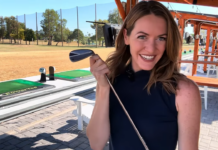As Chubbs from Happy Gilmore said: It’s all in the hips! Actually, yes, a (lot of a) good swing is
It’s often said golf is a complicated game; one that can easily leave you confused and frustrated.
Never more does this ring true if you’re trying hard to get better, but don’t have any real clue on where to start. So, here’s an obvious statement to get things going: The key to improving how you hit the ball and every aspect of your game is knowing exactly what to work on, and what to work on first!
An example of this with students at GolfTEC over the past 20 years is they often hit the ball fat or thin, but don’t understand the causing factors and may work on the incorrect things to improve.
 In many cases, an improper “low point” of the swing is a major contributor to these shots, which is a helpful first step to understand as an effect of a swing component that can be improved. This means the arc of the golfer’s swing bottoms out behind, or not far enough ahead, of the golf ball. Aside from those ugly chunked or bladed shots, this issue can also cause a lack of distance from an “unsolid” strike.
In many cases, an improper “low point” of the swing is a major contributor to these shots, which is a helpful first step to understand as an effect of a swing component that can be improved. This means the arc of the golfer’s swing bottoms out behind, or not far enough ahead, of the golf ball. Aside from those ugly chunked or bladed shots, this issue can also cause a lack of distance from an “unsolid” strike.
Now on to the cause …
Improved low point from proper hip movement
One the main body measurements we analyze in students at GolfTEC is how the hips move in the swing; something we call “hip sway.” We place a sensor that sits at the base of your spine, and along with other measurements, it quantifies how your hips move laterally toward or away from the target while you swing.
As we now factually know the average hip sway movement of a 30 handicapper scaled to a PGA Tour player, our SwingTRU Motion Study revealed quantified data of how a golfer’s hips move in direct correlation to skill level.
The tour pro, for example, has an average hip movement of 3.9 inches toward the target at the top of the backswing. This means what many learning golf have often been told — get over to your trail side leg (away from the target) and “coil” up for power — has been factually disproven when it comes to data-analyzed measurements of the world’s best golfers.
That notion also directly correlates to the 30 handicap’s hip movement, as they have an average hip sway of just 2.3 inches toward the target. This may not sound like much of a difference, but it’s HUGE in terms of the effect on a golf swing!
It’s also a key contributor to the high-handicapper’s low point not occurring far enough ahead of the ball in comparison to the tour pro, whose swing is close to ideal in this area.
This video explains further:
VIDEO: Hip sway explained by SwingTRU
Why this difference in hip movement causes fat and thin shots
When the hips move toward the target in the backswing — in another obvious, but relevant statement — it prevents the golfer from moving laterally away from the target during that part of the swing, which is the classic golfer “swaying” problem!
This lateral move away from the target likewise moves the low point location away from the target if not changed before impact, therefore requiring an extra move toward the target in the downswing to move its location back in front of the ball to hit a solid shot. Read: The cause of your fat and thin shots.
How to improve your hip movement for better golf shots!
The explanation of improper hip movement causing bad shots sounds easy enough, right? Then why don’t more golfers know to work on this and never struggle with it again?
I’d say for three main reasons:
- The conflicting advice prevalent in golf makes it hard to know what to even believe. Just listen to any two golf instructors out there who don’t use the aid of technology to teach, and you’ll often get two different answers.
- There’s sometimes an innate instinct to “help” the ball up in the air, meaning golfers feel they need to move backward away from the ball in the backswing to make this happen.
- Even if the player knows they need to work on their hip movement, what they think they’re doing vs. what they’re actually doing are often two totally different things. That’s why the visual feedback of video practice can help greatly.
So, to break down a simple remedy to improve your hip sway — something you can even do at home — try the Chair Drill, as shown in the video below:
VIDEO: The Chair Drill to improve hip sway
How to always know where to start with your golf improvement
One way is to of course get measured by a Certified Personal Coach in your local GolfTEC Improvement Center!
But when you’re out on the range working on your own, it’s wise to first understand how golf ball flight laws affect every single shot you hit as the ultimate starting place to improve.
From there, knowing the common swing flaws often contributing to various ball flights, as explained in the six highlighted positions of the GolfTEC SwingTRU Motion Study, will help you create a better understanding of what’s happening in your golf swing. Then, finally, you’ll have a real clue on what to work on in your efforts to improve.
Like our content? Subscribe to the GolfTEC Scramble for the latest on instruction, news, equipment and more!









My coach Matt Barton always knows how to get his point across. He has helped me greatly. Rick Morey Columbia S.C